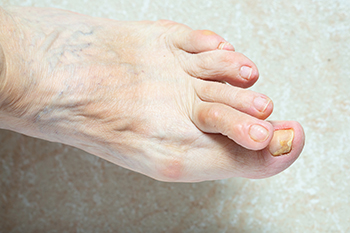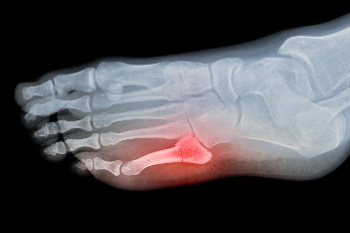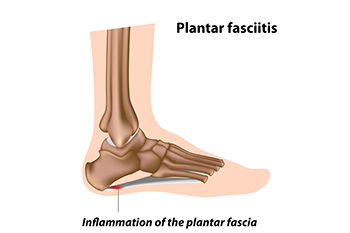Items filtered by date: September 2025
Hammertoe and Its Impact on Foot Mechanics and Plantar Fascia Strain

Hammertoe is more than a visible deformity of the smaller toes. The bent position alters how the foot bears weight and shifts pressure across the lower extremity. As the toes contract, the forefoot absorbs greater force, changing walking patterns and placing extra stress on the plantar fascia, which is the band of tissue on the bottom of the foot. This strain can trigger heel pain or plantar fasciitis, which in turn may further disrupt normal gait. Over time, a cycle develops where abnormal mechanics worsen both the toe deformity and the surrounding soft tissue irritation. Muscle imbalance and tendon tightness may also contribute to ongoing damage, making correction more difficult as the condition progresses. Wearing supportive footwear, targeted stretching, and orthoses can help reduce stress on the toes and fascia, but advanced cases may require surgical correction. If you are experiencing painful changes linked to hammertoe, it is suggested that you consult a podiatrist for evaluation and appropriate treatment.
Hammertoes can be a painful condition to live with. For more information, contact One of our podiatrists of Foot and Ankle Medical Center. Our doctors will answer any of your foot- and ankle-related questions.
Hammertoe
Hammertoe is a foot deformity that occurs due to an imbalance in the muscles, tendons, or ligaments that normally hold the toe straight. It can be caused by the type of shoes you wear, your foot structure, trauma, and certain disease processes.
Symptoms
- Painful and/or difficult toe movement
- Swelling
- Joint stiffness
- Calluses/Corns
- Physical deformity
Risk Factors
- Age – The risk of hammertoe increases with age
- Sex – Women are more likely to have hammertoe compared to men
- Toe Length – You are more likely to develop hammertoe if your second toe is longer than your big toe
- Certain Diseases – Arthritis and diabetes may make you more likely to develop hammertoe
Treatment
If you have hammertoe, you should change into a more comfortable shoe that provides enough room for your toes. Exercises such as picking up marbles may strengthen and stretch your toe muscles. Nevertheless, it is important to seek assistance from a podiatrist in order to determine the severity of your hammertoe and see which treatment option will work best for you.
If you have any questions, please feel free to contact our offices located in New Port Richey and Spring Hill, FL . We offer the newest diagnostic and treatment technologies for all your foot care needs.
Common Foot Problems in Seniors

As people age, foot problems become more common and can affect mobility and quality of life. Arthritis leads to joint stiffness, swelling, and pain that limit movement. Bunions cause a bony bump on the side of the big toe, leading to discomfort and difficulty finding proper shoes. Plantar fasciitis results in sharp heel pain, especially with the first steps in the morning. Additionally, diabetic foot problems may include numbness, poor circulation, and wounds that heal slowly, increasing the risk of infection. A podiatrist can help by diagnosing these conditions, providing custom treatments, recommending supportive footwear, and preventing complications. If you are elderly and foot pain or changes in your feet are interfering with daily activities, it is suggested that you promptly consult a podiatrist who can guide you toward effective relief solutions.
Proper foot care is something many older adults forget to consider. If you have any concerns about your feet and ankles, contact One of our podiatrists from Foot and Ankle Medical Center. Our doctors can provide the care you need to keep you pain-free and on your feet.
The Elderly and Their Feet
As we age we start to notice many changes in our body, but the elder population may not notice them right away. Medical conditions may prevent the elderly to take notice of their foot health right away. Poor vision is a lead contributor to not taking action for the elderly.
Common Conditions
- Neuropathy – can reduce feeling in the feet and can hide many life-threatening medical conditions.
- Reduced flexibility – prevents the ability of proper toenail trimming, and foot cleaning. If left untreated, it may lead to further medical issues.
- Foot sores – amongst the older population can be serious before they are discovered. Some of the problematic conditions they may face are:
- Gouging toenails affecting nearby toe
- Shoes that don’t fit properly
- Pressure sores
- Loss of circulation in legs & feet
- Edema & swelling of feet and ankles
Susceptible Infections
Diabetes and poor circulation can cause general loss of sensitivity over the years, turning a simple cut into a serious issue.
If you have any questions, please feel free to contact our offices located in New Port Richey and Spring Hill, FL . We offer the newest diagnostic and treatment technologies for all your foot care needs.
Are You Suffering From Nerve Damage?
Symptoms and Stages of Gout

Gout is a form of arthritis that commonly affects the feet, especially the big toe joint, and develops when uric acid crystals build up around a joint. The earliest stage of gout, called asymptomatic hyperuricemia, involves crystal deposits without pain. The second stage, acute intermittent gout, is when sudden attacks occur, often at night or early in the morning. These episodes cause severe pain, redness, swelling, and warmth in the affected toe, ankle, or foot joint. It sometimes makes it difficult to walk or even touch the area. If gout is not properly managed, it can progress to chronic tophaceous gout, where hard deposits, known as tophi, form under the skin or within joints. This advanced stage can cause ongoing pain, deformity, stiffness, and limited mobility in the toes, feet, or ankles. If you are experiencing foot pain related to gout, it is suggested that you make an appointment with a podiatrist for a diagnosis and ongoing help managing this painful condition.
Gout is a foot condition that requires certain treatment and care. If you are seeking treatment, contact One of our podiatrists from Foot and Ankle Medical Center. Our doctors will treat your foot and ankle needs.
What Is Gout?
Gout is a type of arthritis caused by a buildup of uric acid in the bloodstream. It often develops in the foot, especially the big toe area, although it can manifest in other parts of the body as well. Gout can make walking and standing very painful and is especially common in diabetics and the obese.
People typically get gout because of a poor diet. Genetic predisposition is also a factor. The children of parents who have had gout frequently have a chance of developing it themselves.
Gout can easily be identified by redness and inflammation of the big toe and the surrounding areas of the foot. Other symptoms include extreme fatigue, joint pain, and running high fevers. Sometimes corticosteroid drugs can be prescribed to treat gout, but the best way to combat this disease is to get more exercise and eat a better diet.
If you have any questions, please feel free to contact our offices located in New Port Richey and Spring Hill, FL . We offer the newest diagnostic and treatment technologies for all your foot care needs.
Types of 5th Metatarsal Fractures

A fracture of the 5th metatarsal, the long bone on the outside of the foot that connects to the little toe, can occur in several locations and patterns. One common type is an avulsion fracture, where a tendon or ligament pulls off a small piece of bone near the base of the metatarsal. Another type is a Jones fracture, which occurs slightly farther along the base, and is known for slower healing due to limited blood flow in that region. Additionally, a dancer’s fracture is an oblique break through the shaft of the bone, often caused by twisting or an awkward landing. These 5th metatarsal injuries typically result in pain, swelling, bruising, and difficulty walking. Proper diagnosis with imaging is important to distinguish between the types, as each can require a different treatment approach. A podiatrist can evaluate the extent of the injury and recommend immobilization or surgery, when necessary. If you believe you may have fractured a bone in your foot, it is suggested that you schedule an appointment with a podiatrist for an exam and appropriate treatment solutions.
A broken foot requires immediate medical attention and treatment. If you need your feet checked, contact One of our podiatrists from Foot and Ankle Medical Center. Our doctors can provide the care you need to keep you pain-free and on your feet.
Broken Foot Causes, Symptoms, and Treatment
A broken foot is caused by one of the bones in the foot typically breaking when bended, crushed, or stretched beyond its natural capabilities. Usually the location of the fracture indicates how the break occurred, whether it was through an object, fall, or any other type of injury.
Common Symptoms of Broken Feet:
- Bruising
- Pain
- Redness
- Swelling
- Blue in color
- Numbness
- Cold
- Misshapen
- Cuts
- Deformities
Those that suspect they have a broken foot shoot seek urgent medical attention where a medical professional could diagnose the severity.
Treatment for broken bones varies depending on the cause, severity and location. Some will require the use of splints, casts or crutches while others could even involve surgery to repair the broken bones. Personal care includes the use of ice and keeping the foot stabilized and elevated.
If you have any questions, please feel free to contact our offices located in New Port Richey and Spring Hill, FL . We offer the newest diagnostic and treatment technologies for all your foot care needs.
Plantar Fasciitis and Podiatry Care

Plantar fasciitis is a common foot condition that occurs when the plantar fascia, a thick band of tissue running along the bottom of the foot, becomes inflamed. It often develops from repetitive stress, overuse, flat feet, high arches, or wearing shoes that lack adequate support. Risk factors include obesity, prolonged standing, excessive running, and tight calf muscles. Symptoms typically involve sharp heel pain, especially with the first steps in the morning, swelling, and stiffness. A podiatrist can help by evaluating foot mechanics, prescribing custom orthotics, and suggesting stretching exercises and supportive footwear. Providing targeted treatments to reduce inflammation and pain are other factors. If you have heel pain, it is suggested that you schedule an appointment with a podiatrist who can accurately diagnose and treat plantar fasciitis.
Plantar fasciitis is a common foot condition that is often caused by a strain injury. If you are experiencing heel pain or symptoms of plantar fasciitis, contact One of our podiatrists from Foot and Ankle Medical Center. Our doctors can provide the care you need to keep you pain-free and on your feet.
What Is Plantar Fasciitis?
Plantar fasciitis is one of the most common causes of heel pain. The plantar fascia is a ligament that connects your heel to the front of your foot. When this ligament becomes inflamed, plantar fasciitis is the result. If you have plantar fasciitis you will have a stabbing pain that usually occurs with your first steps in the morning. As the day progresses and you walk around more, this pain will start to disappear, but it will return after long periods of standing or sitting.
What Causes Plantar Fasciitis?
- Excessive running
- Having high arches in your feet
- Other foot issues such as flat feet
- Pregnancy (due to the sudden weight gain)
- Being on your feet very often
There are some risk factors that may make you more likely to develop plantar fasciitis compared to others. The condition most commonly affects adults between the ages of 40 and 60. It also tends to affect people who are obese because the extra pounds result in extra stress being placed on the plantar fascia.
Prevention
- Take good care of your feet – Wear shoes that have good arch support and heel cushioning.
- Maintain a healthy weight
- If you are a runner, alternate running with other sports that won’t cause heel pain
There are a variety of treatment options available for plantar fasciitis along with the pain that accompanies it. Additionally, physical therapy is a very important component in the treatment process. It is important that you meet with your podiatrist to determine which treatment option is best for you.
If you have any questions, please feel free to contact our offices located in New Port Richey and Spring Hill, FL . We offer the newest diagnostic and treatment technologies for all your foot care needs.

